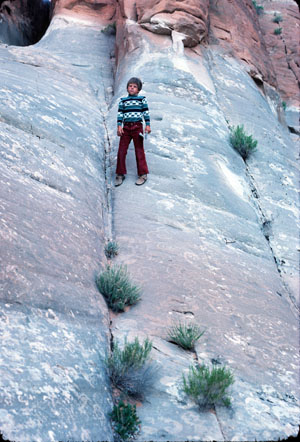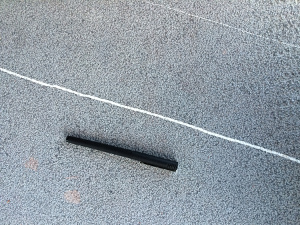| |||||||
|
|
|||||||
|
|
|||||||
| Joints | |||||||
|
Joints, as seen in Figure 1, are planar geological structures across which displacement discontinuities are predominantly normal to the plane of the structure; that is, the two surfaces defining the structure have moved away from each other in a direction predominantly perpendicular to the surfaces (see Figure 1 of Fractures for a schematic diagram illustrating the kinematics). Joints are sometimes called dilating fractures, opening fractures, extension fractures, cracks, and fissures (Pollard and Aydin, 1988). Joints are also named according to their relationships to each other and to other structures. Examples of this type of terminology include en echelon joints, composite joints, splay joints, and cross joints. En echelon or simply echelon joints are joints broken up into segments with sub-parallel arrangement. Composite joints are characterized by many segments slightly offset across planar anisotropies or inhomogeneities in rocks, for example, bed interfaces. Splay joints are associated with shearing of an earlier discontinuity and branching of an earlier fracture. Cross joints or cross strike joints (Engelder and Geiser, 1980) refer to those joints perpendicular to the structural grain generally in fold and thrust belts. With respect to bedding, joints may be referred to as bed-parallel and bed-perpendicular (see also Joint Orientation). When joints are wholly or partially filled with hydrothermal minerals, they are called veins (Figure 2 and Figure 3). Fluids that pass through fractures, especially at high temperatures and with large enough pressure drop, can deposit minerals that fill the fractures and form veins, the thicknesses of which are a measure of the opening during the precipitation. The aperture of the initial fracture and the aperture during the precipitation are different as indicated by various thicknesses ranging from hairline to as much as 3.5 mm in Figure 3. Similarly, dikes filled by magma solidified later represent the same type of structure, often at larger scale.
Joints may also be classified based on their geneses, such as tectonic joints, cooling (thermal) and desiccation joints, exfoliation joints, and releasing joints, etc. Joint surfaces are commonly decorated by plumose structures to be described in the section titled 'Physical Properties of Joints' and 'Joint Surface Morphology-Plumose Structure.' There is a discipline of science called fractography that deals with fracture surface features (Kulander et al., 1979; Bahat et al., 2005). Joints form in rock by the opening mode fracturing mechanism, with the least principal stress (tension being negative) oriented perpendicular to the joint planes. This subject is discussed in detail in the section titled 'Mechanisms and Mechanics of Joints.' In addition, many geometric and statistical characteristics of joints are presented under 'Geostatistical Properties of Joints.' | |||||||
| Types of Joints: | |||||||
| Splay JointsEchelon JointsFringe JointsComposite JointsColumnar JointsHybrid Joints | |||||||
| Reference: |
|||||||
| Bahat, D., Rabinovitch, A., Vladimir, F., 2005 Cruikshank, K.M., Aydin, A., 1995 Dyer, J.R., 1983 Engelder, T., Geiser, P.A., 1980 Kulander, B.R., Dean, S.L., Barton, C.C., 1979 Pollard, D.D., Aydin, A., 1988 |
|||||||
|
Readme | About Us | Acknowledgement | How to Cite | Terms of Use | Ⓒ Rock Fracture Knowledgebase |
|||||||


